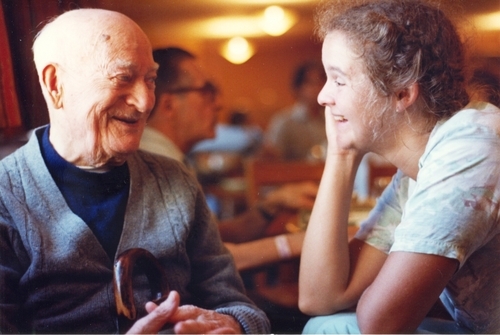Costeloe, James Geoffrey: my Army recollections (December 6, 1983)
ABSTRACT: Maj. James Geoffrey Costeloe Border Regiment 1st Airborne Division Costeloe_J_0041_01.mp3 Born the son of a parish vicar on Dec. 4, 1920 in Nottingham, Eng. Joined The Border Regiment as a Private in May 1939 with the object, after eighteen months, of going to Sandhurst. The war intervened and he was commissioned into the regiment in March 1940 after a short course at an O.C.T.U. in Aldershot. He later instructed at the same unit before being posted to the 1st Battalion, The Border Regiment in South Wales. In 1942 The Border Regiment was chosen to form part of the 1st Airlanding Brigade (glider-borne troops) of the 1st Airborne Division. Sent to North Africa in 1943, they formed part of the invasion forces for Sicily. Describes training, including two glider crashes which he survived. The most common glider was the "Horsa" which was able to carry thirty troops, or one jeep and trailer, or a six-pounder anti-tank gun. In the attack on Sicily a considerable proportion of the battalion landed in the sea (but not eighty percent as quoted), including Maj. Costeloe, but after several hours they were picked up by a troopship. The battalion was reformed in North Africa prior to the next operation at Taranto, It. After a high speed trip aboard a Royal Navy cruiser, during which they saw the Italian fleet sailing to Malta to surrender, they disembarked at Taranto and dug in about five miles beyond the city. Next they secured the airfield at Foggia for the R.A.F. During this time they only encountered light German opposition. Contracted jaundice and spent some time in hospital. After recovery, he was able to rejoin the unit on its return to England to prepare for the invasion of France. Transferred to the 1st Airborne Division Reconnaissance Squadron as adjutant. Describes the equipment and complement of the squadron. Later they were to be the only mobile troops at Arnhem. (30:00) On D Day (June 1944) the 1st Airborne Division was held in reserve. Considerable frustration: briefed for a dozen operations, actually airborne for one before it was cancelled; they did not get into action until Arnhem. Great confidence in success going into Arnhem, but actually landed too far from the target. Strong German opposition almost immediately. After heavy fighting they found themselves effectively boxed into a defensive perimeter. After nine or ten days those that remained were able to reach the Rhine and withdrew across the river. (45:00) Comments on severe radio communication problems. Back in England applied for a staff position, was accepted and, after staff college, was sent to the 14th Army in India and Burma. A few months later he was seconded to the Burma Police where he formed a 750-man Frontier Battalion. Lost his police position when the British withdrew from Burma. Managed a rubber plantation for a period, but corruption was so rife in the Burmese administration that he felt it necessary to move on to Malaya where he was assistant manager on a very large plantation. Married in Singapore. With the "Emergency" he felt that living in the country was consistently dangerous and resolved to move to Canada in 1951. A few months after arriving he joined the Princess Patricia's Canadian Light Infantry, commanding "C' Company in Korea. (13:00) Although the interviewer indicates that more was to come, nothing is available on the recording. Note: Maj. Costeloe referred to John Fairley, Remember Arnhem, a history of the 1st Airborne Reconnaissance Squadron, for which he was extensively interviewed.
Rank: Major.
Interviewee: Costeloe, James Geoffrey, b. 1920
An interview/narrative of James Geoffrey Costeloe's experiences during World War II and the Korean War. Major Costeloe served with the Border Regiment and the 1st Airborne Division. Interview took place on December 6, 1983.
Interviewer: Witzel, Morgen
- In Collection:
- Arnhem, Battle of, Arnhem, Netherlands, 1944
- Great Britain--Army--Officers--Training of
- Malaya--History--Malayan Emergency, 1948-1960
- Costeloe, James Geoffrey, 1920-2009--Interviews
- Great Britain--Army--Airborne Division, 1st--Reconnaissance Squadron
- D-Day, 1944 (Normandy invasion)
- Great Britain--Army--Border Regiment--Battalion, 1st
- Great Britain--Army--Army, XIV
- World War, 1939-1945--Campaigns--France--Normandy
- Taranto, Battle of, Taranto, Italy, 1940
- Korean War, 1950-1953--Personal narratives, Canadian
- Korean War, 1950-1953--Campaigns
- Airspeed Horsa (Glider)
- Foggia Plain (Italy : Airfield)
- Gliders (Aeronautics)
- World War, 1939-1945--Campaigns--Italy--Sicily
- Canada--Canadian Army--Princess Patricia's Canadian Light Infantry
- Great Britain--Army--Border Regiment
- Burma Frontier Force
- Great Britain--Army--Airborne Division, 1st--Airlanding Brigade, 1st
- World War, 1939-1945--Personal narratives, Canadian
- World War, 1939-1945--Medical care
- World War, 1939-1945--Campaigns--Burma
- Great Britain--Army--Airborne Division, 1st
- 1 sound recording (MP3)
- 49, 0
- 36.5, 127.75
- 40, 127
- 60.10867, -113.64258
- 54.75844, -2.69531
- One original sound tape reel (ca. 60 min.) : 1 7/8 ips, 2 track, mono. ; 1 sound cassette copy : standard, mono. in Special Collections.
- Canadian Military Oral History Collection
- CJG_041
- Special Collections Finding Aid: https://search.archives.uvic.ca/reginald-herbert-roy-fonds
- May 24, 2007
- Digital sound recording in .wav format at 16 bits and 22 kHz. In .mp3 format at 64 kbps and 22 kHz. Digitized by AN, technical and cataloguing metadata provided by JF and JP. Transferred from audio reel to audio cassette between 1987-1997. Interview migrated to digital format for UVic Special Collections in 2007. Migration metadata by KD and MT.
- Rights
- This interview has been posted with the understanding that it may be used for research purposes only. Should the interviewee or their heirs have any objections to this interview being accessible on the Internet, it will be removed promptly. Contact UVic Special Collections for permission if using for other than research purposes: speccoll@uvic.ca
- DOI
